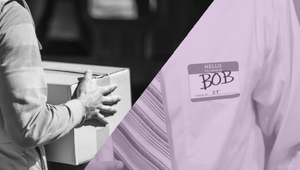
Why You Must Think Creatively About Business Transformation

With increasing talks around inflation, the worsening global economic situation and cost of living crises being felt by people worldwide, there's a real concern in the industry that businesses will put creativity on the back burner when it comes to their priorities. However, Deloitte Digital says that its Creative Business Transformation Study and its findings are proof that this is not the way to go.
Discussing why Deloitte Digital performed the study and what it means for the future, LBB’s Ben Conway spoke with the agency’s US chief creative officer, Leslie Sims, who says: “The purpose behind the study was quite simple - bringing awareness to the growing creativity gap and the impact it’s having on businesses around the world. We live in an ever-changing world that is primed for and seeking innovative solutions at every corner. New technology and cultural, political and pandemic-related shifts have been driving the desire for new solutions to drive efficient growth while leaving creativity behind. This results in many businesses bottlenecking creativity by shifting away from creative skill sets and talent, including chief creative officers.”
Leslie says that since the emergence of Silicon Valley around a decade ago, technology has been the driver for innovation - resulting in a focus almost exclusively on growth, leaving creativity behind. The Creative Business Transformation Study defines this as “the creativity gap”. According to Leslie, the number of global C-suite roles with a specific focus on growth, such as chief revenue or growth officers, has increased dramatically (256% and 554%, respectively) and at a much faster rate than CMOs (51%). Also, despite rapid growth between 2011 and 2018, the number of chief creative officers has declined 4% over the last four years, which Leslie says indicates a dramatic shift away from creative skill sets and talent that isn’t just limited to the C-suite.
“We were surprised to see the numbers of chief revenue/growth/brand officers grow so quickly while numbers of chief marketing officers shrank. Where do growth, revenue and customers all come from?!” Leslie continues, “Also, the number of CCOs declining, given the number of new in-house agencies on the landscape, was also really eye-opening. All this just means there are fewer seats at the table for people advocating on behalf of using creativity to solve business problems at a time when business needs creative solutions most.”
She adds. “Hopefully these findings will cause business leaders to wake up and realise they can’t just fill their C-Suites and boards with logic and data-driven mindsets. As Rory Sutherland says, ‘If the world’s most persistent problems could be solved logically, we would’ve solved them already.’ We need to make more space for blue sky thinking to solve the business issues of tomorrow.”
Unless businesses actively work to reverse this trend, the Deloitte Digital CCO predicts that the gaps will only continue to grow. She suggests that marketing and creative leaders need to be encouraged to apply creativity across all areas of their businesses, so that they can “differentiate from the competition” through creative business transformation. “While creative industries can experience their own lulls in creative, innovative solutions, the creativity gap is affecting all industries across the board. The creativity gap developed simultaneously as we all experienced monumental changes and shifts across multiple landscapes that affect our daily lives, but that’s not to say that we can’t reverse it and work to infuse creativity back into businesses.”
Explaining why agencies and brands have focused on growth, at the cost of creativity, Leslie puts it down to a “state of major innovation” that occurred during the last decade - driven by new startups and tech companies that had growth-over-everything approaches. Now altering the focus brands should rely on their creativity and new ideas to set themselves apart and stay ahead of the curve, she says. “At times it’s easy to forget that creativity plays a central role in driving growth and bringing meaningful change to both businesses and their customers.”
To help businesses drive growth and make meaningful change through creativity, Deloitte Digital - in partnership with LIONS - provides a comprehensive plan for closing creative gaps in the Creative Business Transformation Study, featuring three techniques:
- Find hidden creatives: Inspiration can come from anywhere - from frontline employees, customers or partners. As such, forward-looking brands should encourage and consider all potential sources for the next big idea.
- Curate creative excellence patiently: Many promising ideas need guidance and cultivation to reach their full potential. Business transformation is no different.
- Widen the accountability lens: Many creative and impactful brands understand the scale of a business transformation is only as extensive as its corresponding measurement.
“These three solutions come together to build the blueprint for highlighting the importance of creativity and expanding the way businesses look at creative solutions,” says Leslie.
The study also reveals that the most successful applications of creativity in business transformation came from brands and agencies who were not just willing to try something new, but proactively sought out opportunities to do so, without being forced by external factors. Leslie explains that when businesses put creativity and innovation first in this way, they have an advantage in the industry. “Infusing creativity into business transformation is powerful; it can set organisations apart and lead to significant growth. Two recent examples would be our work with ‘Uplink’ and ‘Terre des Hommes’.”
In 2020, the World Economic Forum tapped Deloitte Digital to help find a solution to the lack of convergence that exists between world-changing ideas and the resources needed to bring them to life. In collaboration with Salesforce, Deloitte Digital brought together an entire ecosystem and helped architect ‘UpLink’, a platform that inspires innovation and connects innovators to investments, resources, community and influence. Leslie says, “Uplink is a new social network that turned the most powerful tool in the planet into the most powerful tool for the planet and allows innovators to pick their goal, pitch their idea and connect with a network that can scale their project.”

With Terre des Hommes, an NGO working for gender equality in Italy, Deloitte Digital launched the ‘#UnaStatuaPerLeBambine’ (a statue for the children) movement - inviting the inhabitants of Milan to ask the municipality for the first statue of a woman in the city. Then came ‘DiscovHery Billboards’, the first child height mini-billboard campaign that offers a new perspective on the city's monuments. “On the heels of the creativity-driven campaign, and with no media budget, the campaign saw a reach of 48 million due to organic online impact driven by the support of institutional representatives, celebrities, influencers and journalists,” she says. “The campaign resulted in the first statue of a woman in Milan, dedicated to Cristina Trivulzio di Belgiojoso, spurred by Deloitte Digital’s desire to create purpose-driven solutions.”
An important finding in the study is that brands need to “push the scope of transformation beyond standard business objectives” - this means infusing creativity and business transformation into business goals in order to evolve and be sustainable. Leslie says that Deloitte Digital uses this philosophy from the very beginning to ensure that clients find solutions in a creative manner - and that, following this research, they will continue to align creativity with business transformation to help brands truly live their purpose.
“Embedding creativity into the way businesses solve their problems and creating purpose-driven solutions that transform the way they operate while growing their bottom line is a principle Deloitte Digital stands by and looks towards for the future.”
In the not-so-distant future, however, such optimism may be hard to come by. According to Deloitte’s quarterly CFO Signals report released in August 2022, 46% of surveyed CFOs expect the North American economy to be in a recession by the new year - and brands are taking notice, with CFOs preparing to cut down on expenses. So with the global economic conditions showing little-to-no signs of improvement as we come to the end of 2022, can we expect creativity to remain on the back burner as marketing budgets continue to tighten? Fortunately, the aforementioned CFO signals report does have some good news for creative business transformation, stating that - in spite of these conditions - 38% of surveyed CFOs are prepared to take greater risks to give themselves and brands an edge to succeed when the economy recovers.
Leslie concludes, “As we continue to face uncertainty, it may be tempting to put marketing on the chopping block, as it has historically been the first budget cut, and the last to be reinstated. Agencies and brands must think creatively about business transformation because it’s not enough to win on growth right now, success is created by connecting the right technology, data and creativity to drive innovation.”















